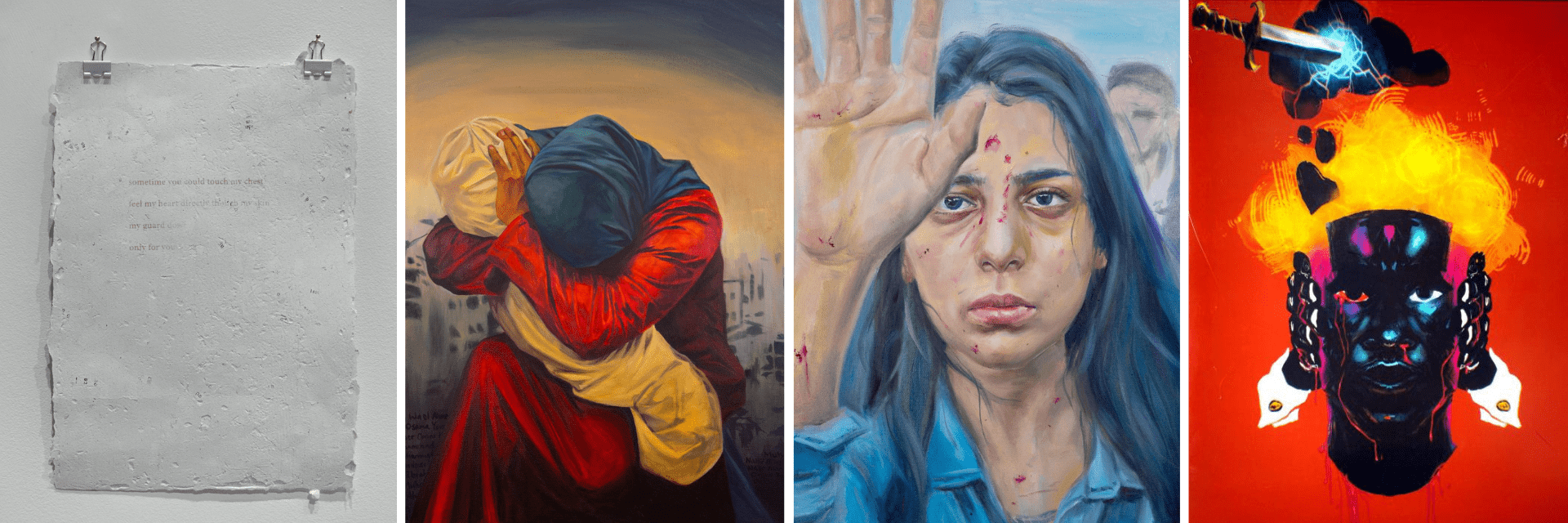2024 Award Winners of The Sadat Arts for Justice and Peace Program
The Anwar Sadat Chair for Peace and Development, housed in the Department of Government and Politics, and Arts for All, in cooperation with the Department of Art, the Department of English and the School of Music, hosted the inaugural year of three competitions: The Sadat Music for Justice and Peace, The Sadat Poetry for Justice and Peace and The Sadat Art for Justice and Peace.
To celebrate the inaugural year of this program and highlight the winners of all three competitions, the Sadat Chair and Arts for All hosted a luncheon with live performances of the two winning music pieces, a reading of the winning poem and showcased the winning artwork. Honorable guests in attendance were members of the selection committee for each competition, the first-place winners, as well as the Deans from both colleges.
We would like to thank all the students who submitted their pieces, making these three competitions possible. We invite all eligible students to consider submitting to next year’s competitions, the theme for which will be released later this year.
About the Program:
The Sadat Arts for Justice and Peace Program originated from the longstanding Sadat Art for Justice and Peace Program. Started in 1998, the Sadat Art for Justice and Peace program is a collaboration between the Anwar Sadat Chair for Peace and Development and the Department of Art at the University of Maryland. The program coincided with former President Jimmy Carter’s Sadat Lecture for Peace and grew into an annual program based on a timely theme related to justice and peace and the ongoing research projects of the Sadat Chair.
For the inaugural year of the expansion of this program into three competitions, the Sadat Arts for Justice and Peace focused on self-expression and freedom of speech. This year’s theme for the three competitions was based on a quote from Frederick Douglass in 1860 about freedom of speech: “To suppress free speech is a double wrong. It violates the rights of the hearer as well as those of the speaker.“
SADAT MUSIC FOR JUSTICE AND PEACE: COMPOSITION FOR CHAMBER MUSIC
The Sadat Music for Justice and Peace Competition: Composition for Chamber Music challenged students in the School of Music to submit an original composition of chamber music that they believed embodied the theme.
The winner of the Composition for Chamber Music Category is “vlug 295” by Johannes Visser, D.M.A. composition student.
Performed by:
Violin I: Alexandra Fitzgerald
Violin II: Max Jacobs
Viola: Emily Bussa
Violoncello: Nailah Harris
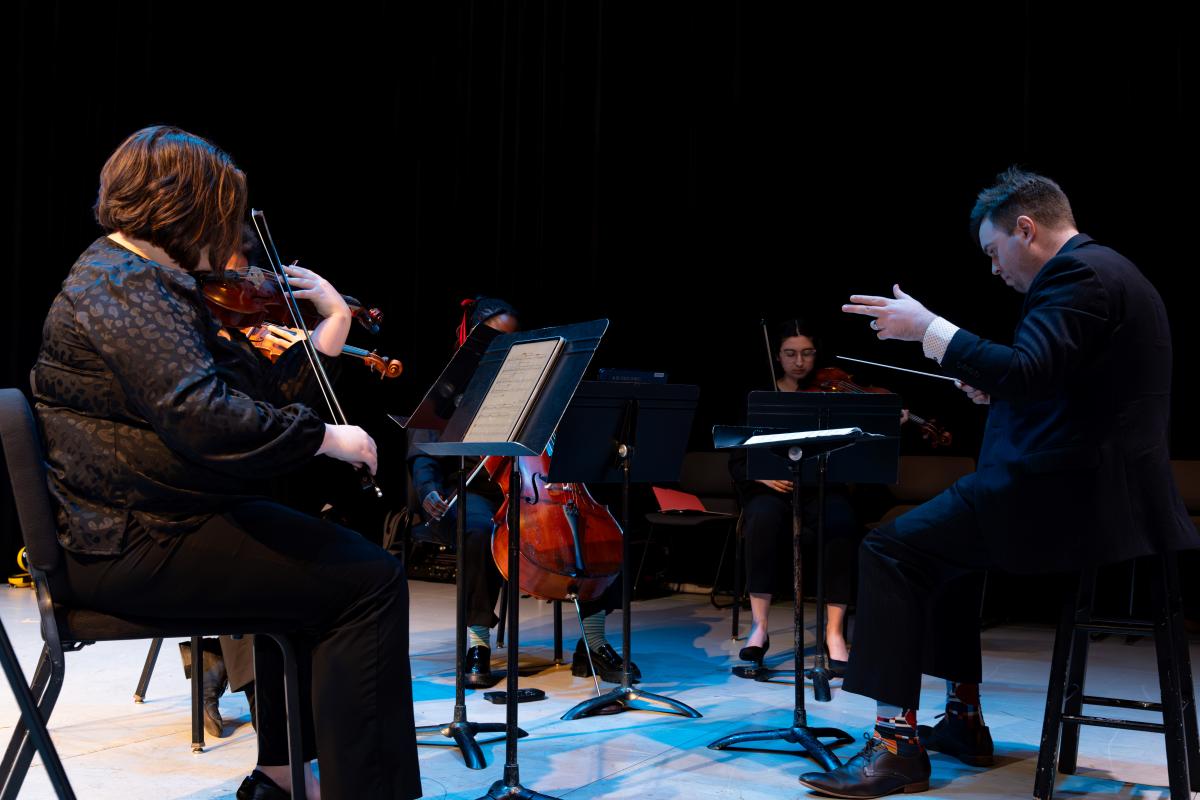
Composer's Statement
This work is a critique of the suppression of not only free speech but also the freedom to be human that was committed by the oppressive South African government at the height of the Apartheid era. Its commentary is exemplified through the metaphor of Flight 295–a South African Airways flight that crashed in the Indian Ocean in the late 1980s. The crimes against humanity committed throughout South Africa by the Apartheid regime find a chilling parallel in the events that caused the crash of Flight 295. En route from East Asia, it is widely acknowledged that the Boeing 747-200 Combi was carrying volatile arms in its cargo compartment. Severe turbulence is said to have caused the arms to destabilize, causing a fire that engulfed the aircraft mid-flight. The recklessness of the government in smuggling unstable black-market arms to South Africa (which would then be used to fight a “war” against people of colour) on board a passenger flight, showed their lack of concern for human life. It is an awareness of these atrocities that this composition strives to share with audiences through the expression of the emotions that I feel when I think of the events of that horrific era in the history of my country and culture.
At the core of this terrible period in my country’s history was a system that suppressed all forms of free speech. Most notable and well-known was how the voice of the great Nelson Rolihlahla Mandela was strangled by the ruling Afrikaans government. However, even the voices of Afrikaans citizens who did not support the Apartheid policies were being suppressed during the 1980s. Artists like Koos Kombuis and Johannes Kerkorrel–both artists who were of the Afrikaans culture (and thus seen as supporting the Apartheid regime purely by cultural association)–vehemently spoke out against the regime. They were seen as traitors “of the culture and of the regime,” for which they both also spent time in jail (albeit much less than the 27 years that Mandela was incarcerated.) It is against these examples of human rights violations that vlug 295 speaks out. Only through communicating the cold facts of these events in undiluted form can we as humans stand a chance of fighting against the continuation of such atrocities across the globe. And as we can see in the media today, the most powerful vessel in such regimes is that of suppressing the voice of the people.
SADAT MUSIC FOR JUSTICE AND PEACE: CHAMBER MUSIC PERFORMANCE
The Sadat Music for Justice and Peace Competition: Chamber Music Performance challenged students in the School of Music to submit a performance of an existing composition that they believed embodied the theme.
FIRST PLACE:
The first-place winner of the Chamber Music Performance is “Concertino for Flute, Viola and Double Bass” by Erwin Schulhoff.
Performed by: Courtney Adams ’24, flute performance; Seth Goodman ’24, viola performance; and Joshua Rhodes, master’s student in double bass performance.
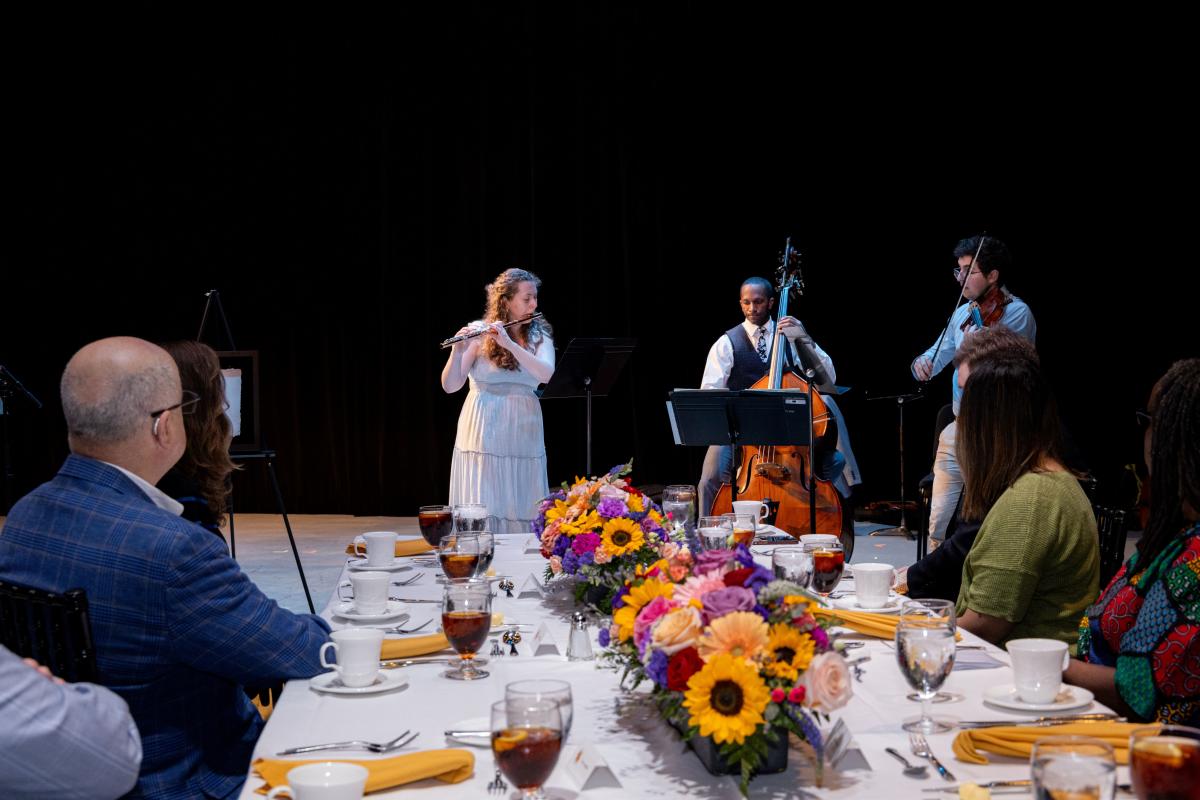
Performers' Statement
The life and compositions of Erwin Schulhoff will forever symbolize the detriment that the silencing of a voice can produce. Schulhoff, an artist with a palette drenched in wonder and innovation, had a unique compositional voice that could have stretched classical music beyond what convention allowed, but instead his voice was swallowed up by hate and misfortune. Our ensemble formed from a desire to share Schulhoff’s profundity, as shown throughout his life and compositions. Through the exploration of his Concertino, our trio has consistently found ourselves taken aback by his genius, while also questioning how much more of an impact the composer would have had if he was able to freely articulate all of his musical ideals.
Erwin Schulhoff was born on June 8, 1894 into a German-Jewish family in Prague. As an adult, his musical pursuit was interrupted heavily due to World War I and the Nazi Party’s invasion of Czechoslovakia. Between being blacklisted by the Nazi Party, Schulhoff only found work as a radio pianist performing under a pseudonym, and eventually tragically died as a Nazi Prisoner at the age of 48.
Schulhoff’s Concertino is written for the unique instrumentation of flute, viola and double bass. This configuration is another nod to Schulhoff’s boldness, pairing perhaps one of the most well-known wind instruments with the stereotypically overlooked viola and bass of the string section, creating not only interesting sonic textures but a great challenge for the performers. Continuing to challenge conventions, Schulhoff introduces the theme of the first movement, an ostinato played by the viola-bass duo which is built on the pentatonic scale. Throughout the piece Schulhoff gives each instrument a chance to showcase itself with melodies and phrases which incorporate elements of jazz and Czech folk music throughout. However, the ostinato, marked “without expression,” continues to return in varied textures, paying homage to Schulhoffs Eastern influence.
Schulhoff’s impact on the world was significantly diminished. Throughout his life he was influenced heavily by expressionism, dadaism, post romanticism, jazz music, Eastern tonalities and social-realism. While living a short life, this composer exposed the world to concepts that were at the forefront of his day. In just a couple of weeks into exploring Schulhoff’s compositions, his music has significantly impacted our musical experiences.
SECOND PLACE:
In second place is “Time to Listen" by David Gibson.
Performed by the UMD Trombone Choir: Marlia Nash ’24, trombone performance; Gilberto Cruz D.M.A. ’24; David Wilson M.M. ’24; Cameron Farnsworth M.M. ’23; Colton Wilson M.M. ’25; and Liam Glinderberg, former D.M.A. student
Performers' Statement
The University of Maryland Jazz Trombone Ensemble presents a soul-stirring composition, "Time to Listen," by David Gibson, as it calls for reflection and impassioned thought. Amidst the unrelenting waves of the Black Lives Matter Movement in the pandemic, this piece serves not only as a musical composition but as a profound testament to the power of art in conveying societal narratives and advocating for change. “Time to Listen” evokes harmonies that weave a tapestry of emotions, echoing the collective yearning for justice, unity and understanding. Within each note lies the echoes of voices long silenced, the cries of those marginalized by systemic inequities and the resolute determination to confront the injustices that pervade our society. This calls for us to pay attention to the Black lives countlessly ignored yesterday and today, but hopefully not tomorrow.
And under the timeless wisdom and guidance of Frederick Douglass, this composition not only amplifies the voices of the oppressed but also underscores the imperative for society to lend a compassionate ear, to acknowledge the realities of systemic oppression and to engage in meaningful dialogue that fosters empathy, understanding and transformative action. “Time to Listen” serves as a poignant reminder of the collective responsibility we bear in confronting prejudice and inequality–challenging preconceived notions and inspiring a commitment to equity and social justice. We believe that music transcends its role as mere entertainment, emerging as a powerful instrument of social change and enlightenment. It is a rallying cry for solidarity, a testament to resilience and an ode to the enduring spirit of hope that fuels the quest for a more just and equitable world. Indeed, it is "Time to Listen"–to the music, to the voices of the marginalized and to the urgent call for collective action in pursuit of a brighter tomorrow.
SADAT POETRY FOR JUSTICE AND PEACE
The Sadat Poetry for Justice and Peace Competition challenged students in the Department of English or the Jiménez-Porter Writers’ House to submit a single unpublished poem that they believed embodied the theme.
FIRST PLACE:
The winning poem of the Sadat Poetry for Justice and Peace is “Rose in the Shredder” by R.C. (submitted anonymously)
SECOND PLACE:
The second-place poem is “Seven Feet Wide” by Ella Gammel ’25, English.
SADAT ART FOR JUSTICE AND PEACE
The Sadat Art for Justice and Peace Competition challenged students in the Department of Art to create any medium, 2D or 3D piece that they believed embodied the theme.
FIRST PLACE:
The first-place winner is “Through My Skin” by Maggie Letvin ’24, immersive media design, studio art and art history.
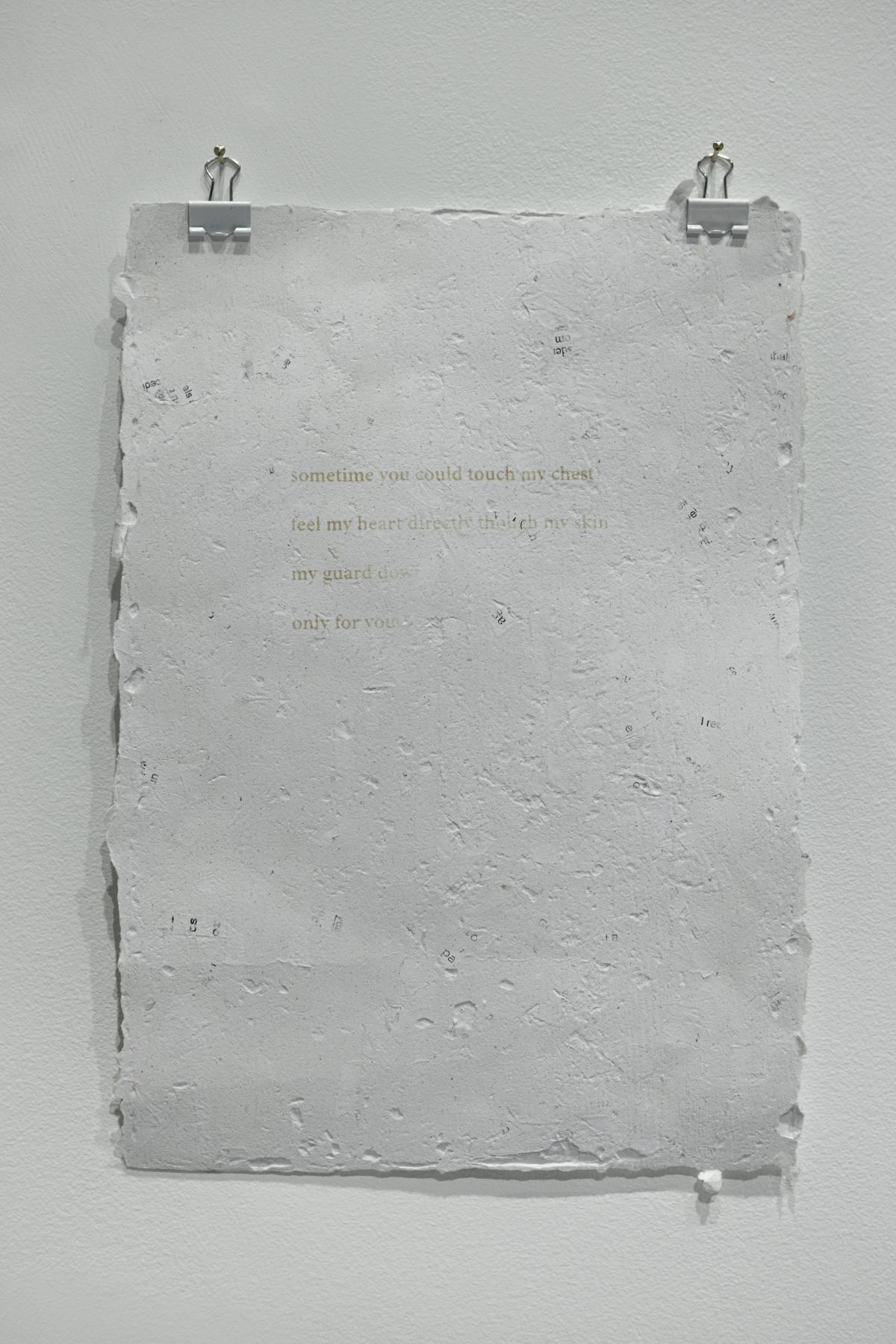
Artist Statement
Through My Skin tackles the battle for transgender rights. It is a poem of queer intimacy laser etched into a handmade paper composed entirely of shredded anti-transgender legislation. Over 440 anti-transgender bills were introduced, engrossed or passed in 2023. That's a total of 3,304 pages that limit trans rights across the country in sports, in the bathroom, in the military, in prison, in schools, in receiving life-saving medical care and in basic access to human needs. These words create a world of hate, directly impacting the lives of trans people across the country, including 16-year-old Nex Benedict who was murdered in the women's restroom of Owasso High School on February 8th, 2024. They were following Oklahoma law that requires students to use the restroom of the sex designated on their birth certificates. Through My Skin serves as a poignant reminder of the violence inflicted upon trans individuals, coupled with quiet peace that is trans joy. Let this artwork be a beacon of hope, illuminating the path towards a future where all voices are heard, and all identities are celebrated without fear or prejudice.
SECOND PLACE:
Second place is “The Innocent Martyrs” by Gina Lee ’25, immersive media design and studio art.

Artist Statement
For this piece, I referenced an award-winning photograph by Mohammed Salem depicting, a mother, Inas Abu Maamar, grieving her deceased child, Saly, in her arms. I specifically chose to reference this photograph because of its prevalence in acknowledging the horrors occurring between Palestine and Israel.
"The Innocent Martyrs" is a piece dedicated to the voice of the suppressed; those who had been lost in the genocide—the innocent lives we have failed to protect. Hidden among the rubble, a mother holds her dead child in the aftermath of explosions in the Gaza Strip. The buried names of babies whose lives were cut short before reaching the age of one are suffocated, their memories struggling to rise above the war-torn scenery. This piece brings forward the current horrors occurring between Palestine and Israel. The piece was inspired by various paintings of The Madonna and Child, homages to the Virgin Mary and Jesus Christ. The two Biblical figures have origins tied to the related nations and were also practicing Judaism; hence the connection between the Torah and the Old Testament within the Bible. I wish to find unity between the three Abrahamic religions to create peace and evoke sorrow. In the Bible, King Herod ordered the massacre of babies to kill Jesus Christ, who was regarded as the King of the Jews and threatened his rule. Now, not only is there a massacre of innocent children but of all people without discrimination.
Yet in this nation of free speech, there is little coverage regarding these deaths; only censorship and erasure. This country's suppression of free speech continues to foster ignorance of the ongoing massacre. Just as we remain ignorant, we remain complacent, allowing these deaths to be simply names buried beneath the cruelty that results from the growing greed of adults at the expense of innocent lives. This is a call for peace: that we couldn’t provide for those lost, but also a call for peace for the lives we can still protect.
THIRD PLACE:
Third place is “The Fight for Speech Freedom” by Derek Chen ’24, studio art.
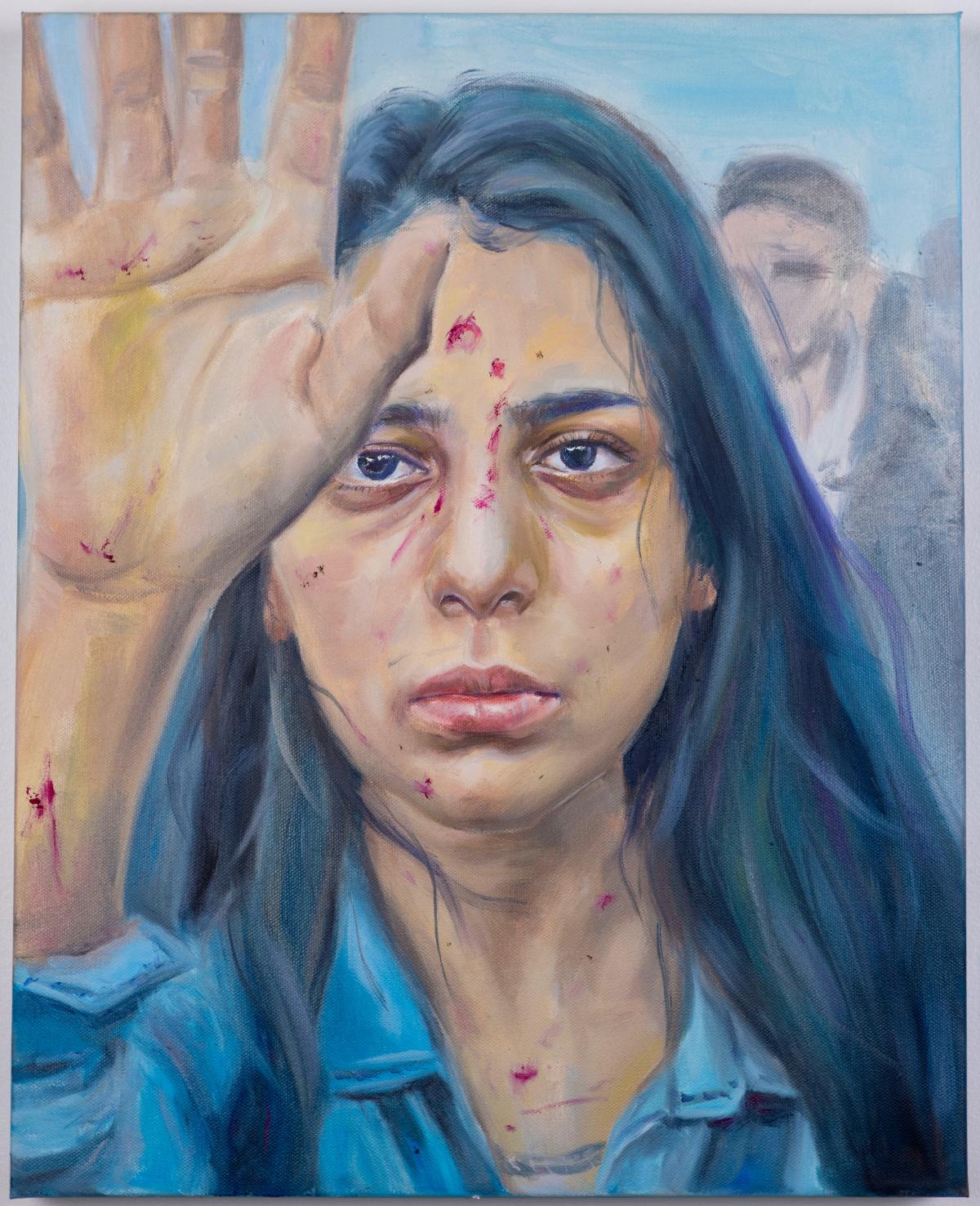
Artist Statement
The tired woman with blood on her face represents the helplessness of being treated unequally. Her act of raising her hands in protest symbolizes the desire for freedom of expression and reflects her resilience and courage. The woman stands for those who are brave for speaking out against injustice and protecting their rights. Her image is a powerful reminder of the necessity to fight for freedom of expression.
HONORABLE MENTION:
An honorable mention among the winning pieces is “Bound by Silence: Suffocated Senses & Shattered Echoes” by Ed-Lamarr G. Petion ’24, supply chain management and marketing.

Artist Statement
Left Piece (Red): Title: "Suffocated Senses"
In "Suffocated Senses," I delve into the profound repercussions of suppressing free speech, particularly within marginalized communities. The fiery backdrop symbolizes the intensity of oppression, while the black man’s figure, adorned with yellow hair, represents the vibrant spirit striving for expression. Yet, the hands covering his ears depict the suffocation of truth, manifested through blood dripping from his senses. The shattered thought bubble, pierced by a golden dagger, vividly illustrates the brutal extinguishing of his inner voice by a gilded blade. This piece serves as a depiction of one half of the dual violation inflicted upon both speaker and listener when free speech is stifled.
Right Piece (Blue): Title: "Shattered Echoes"
In "Shattered Echoes," I confront the suppression of free speech through the lens of a black woman's experience. The somber, murky backdrop mirrors the suffocation of her voice, drowned out by the oppressive forces represented by the ‘powers that be’. Blood trickling, mirroring those in the companion piece, symbolize the violence inflicted upon her silenced words. The shattered speech bubble, cleaved by a crimson ax, starkly portrays the annihilation of her ability to express truth. This artwork serves as a testament to the profound harm inflicted upon individuals and society when voices are silenced.
Sadat Arts for Justice and Peace Luncheon Photography Credit: Kevin Roach/University of Maryland, BSOS
Sadat Arts for Justice and Peace Artwork Photography Credit: John Consoli/University of Maryland

